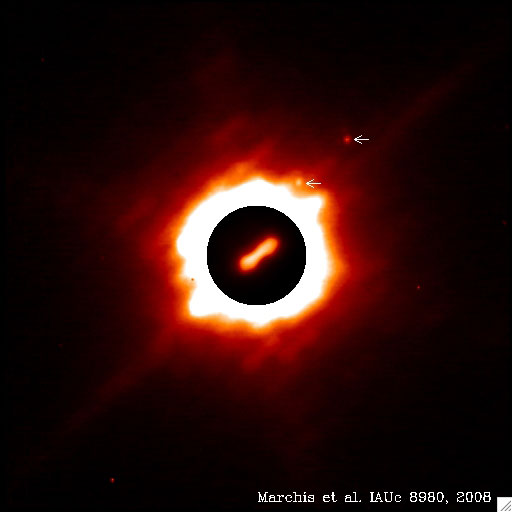Two Companions Found Near Dog-bone Asteroid

A team ofastronomers led by F. Marchis, PI, at the SETI Institute and at UC-Berkeley,and P. Descamps from Paris Observatory announced recently the discovery of twomoons around an intriguing asteroid. The main-belt asteroid 216 Kleopatra hastwo companions.
WhenMarchis observed this asteroid for the first time in October 1999 with the 3.6mtelescope at ESO-LaSilla in Chile, he did not know that he was starting a lengthy quest. Thefirst data recorded with an adaptive optics system, which improves the angularresolution of the image on ground-based telescopes, reveal that the asteroidwas made of two components. One year later, Steve Ostro, astronomer at the JetPropulsion Laboratory, published an article in Science that summarized theanalysis of radar observations that revealed that the mysterious shape of thisM-type, main-belt asteroid. Since then, Kleopatra has been called the"dog-bone" asteroid. Its weird shape is probably the outcome of animpact event. The two lobes could be fragments resulting from the disruption ofa parent asteroid that later gently collided to form a dumbbell-shaped bodywith overall dimension of 135 miles by 58 miles by 43 miles (217 km by 94 km by81 km).
Toreexamine this interesting scenario and better determine the size and shape ofthis fascinating asteroid, Marchis led a team that obtained telescope time toobserve the asteroid in September 2008. The observing schedule allowed the teamto take advantage of the asteroid's position when it was close to Earth at 1.2AU. They used the Keck-II telescope,the largest optical telescope in the world located on the top of Mauna Kea, in Hawaii. The Keck Adaptive Optics system was recently improved and its large 10-m apertureproduces images with an incomparable quality in sharpness (resolution up to0.035"). Using the time-zone difference, Marchis' collaborator, PascalDescamps, located in Paris, France, participated remotely in the observations.Shortly after the first images were recorded and processed, they realized thatthe dog-bone shape model obtained by radar inversion agreed with the directimages recorded at the telescope. Descamps also pointed out that a tiny 3.1mile- (5 km-) sized moon was seen on the first images of Kleopatra. Additionaldata taken during this eventful night revealed a second fainter satellite (2.9mile- or 3 km-sized) that was closer to the primary.
Because ofits elongated and bilobated shape, the team expected to detect companionsaround 216 Kleopatra. They predicted that the rubble-pile structure of theprimary, linked with its fast rotation (~5 h), could result in ejection offragments from the primary after an oblique impact that formed satellites. Itis also possible that these moons are remnant of the catastrophic disruption ofthe parent asteroid, which were subsequently captured.
In 2005 thesame team discovered in the asteroid belt the first triple system composed oftwo moons around87 Sylvia. Two years later, a second triple system (45 Eugenia) wasdiscovered in the main-belt also using an adaptive optics system. These threesystems are strikingly similar since all of them are composed of a largeprimary (diameter larger than 54 miles or 100 km) and their km-sized moonsorbit very close to the primary. Without the improvement in image qualityprovided by the adaptive optics systems installed on Keck's telescopes, thesemultiple asteroid systems would have remained unnoticed.
The teamannounced its discovery in an IAU circular 8980 on September 24. If more dataare collected over the next few weeks, it will be possible to estimate themutual orbits of the satellites and then infer the bulk density of thisinteresting M-type asteroid.
- Video Player: Take One Asteroid - A Recipe for Space Civilization
- Video: Killer Comets and Ominous Asteroids!
- Asteroids at SPACE.com
Breaking space news, the latest updates on rocket launches, skywatching events and more!
